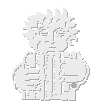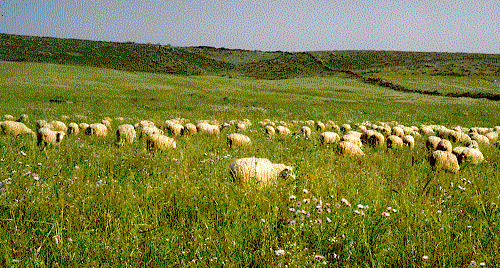 The James Hutton Institute
The James Hutton Institute
This page is no longer updated. The Macaulay Land Use Research Institute joined forces with SCRI on 1 April 2011 to create The James Hutton Institute.
 Improved pastures:
the case of dairy sheep farming systems in Sardinia
Improved pastures:
the case of dairy sheep farming systems in Sardinia
Nicola Fois & Maria Sitzia
In Sardinia the sheep industry is based on a local breed of dairy ewes (3.1 million of heads, bred in 20,000 farms), managed for late autumn lambing and milked between January and June. The grazing flock is generally fed on natural pastures, characterised mainly by annual grass species. The annual pattern of annual herbage availability and its quality are strongly dependent on soil fertility, usually low, and rainfall distribution and amount which is very variable between years. The flow of nutrients and energy from the pasture to the grazing sheep shows two critical constraints: a shortage of herbage availability in winter and a sharp decrease in herbage quality from spring to the next autumn. The availability of summer pasture residues is rather low. Therefore dairy ewes may suffer from undernutrition during pregnancy - early lactation; the nutritional stress is more severe in flocks grazing the inner upland and the southern lowland.

The improvement of natural pasture has been studied in the last 20 years with the aim to increase the availability and quality of dry matter production. The use of self-reseeding Mediterranean species had shown its validity in this field. Nevertheless there is lack of information about grazing management, stocking rate and sustainability of the dairy sheep farming system based on improved pasture.
A three-year research project funded by E.U. (INTERREG contract n°-92-948), carried on in cooperation with C.N.R. "Centre Study Mediterranean Pastures" (Sassari-Italy), focused on improved pasture consisting of burr medic, subclover and annual ryegrass managed either by continuous stocking or rotational grazing, showed that annual ryegrass is more persistent than the other species. Any difference between the two adopted grazing management was found.
Taking into account these results a new three-year E.U. project was set up in October 1996. The objective is to compare two grazing managements of an annual ryegrass pasture maintained under two different stocking rates (6 and 12 ewes/ha) and hence to evaluate the management and stocking rate effects on sward feature and animal performances.
This project enable technicians and farmers to forward the knowledge on livestock farming systems in order to improve the farm productivity and in the meantime, to achieve a better exploitation of the natural resources.
The Istituto Zootecnico e Caseario per la Sardegna, N-W Sardinia, is working
about dairy sheep grazing management in the rainfed lowland and, in
collaboration with the INRA of Corte (Corsica), about the performances of goats
grazing Mediterranean maquis.
| Nicola Fois Maria Sitzia |
| Istituto Zootecnico e Caseario per la Sardegna |
| Km 18.600 S.S. Sassari-Fertilia |
| 07040 OLMEDO (SS) ITALY |
| Tel. (39) 79 387235 Fax (39) 79 389450 |
| E mail: izcszoo@mbox.vol.it |